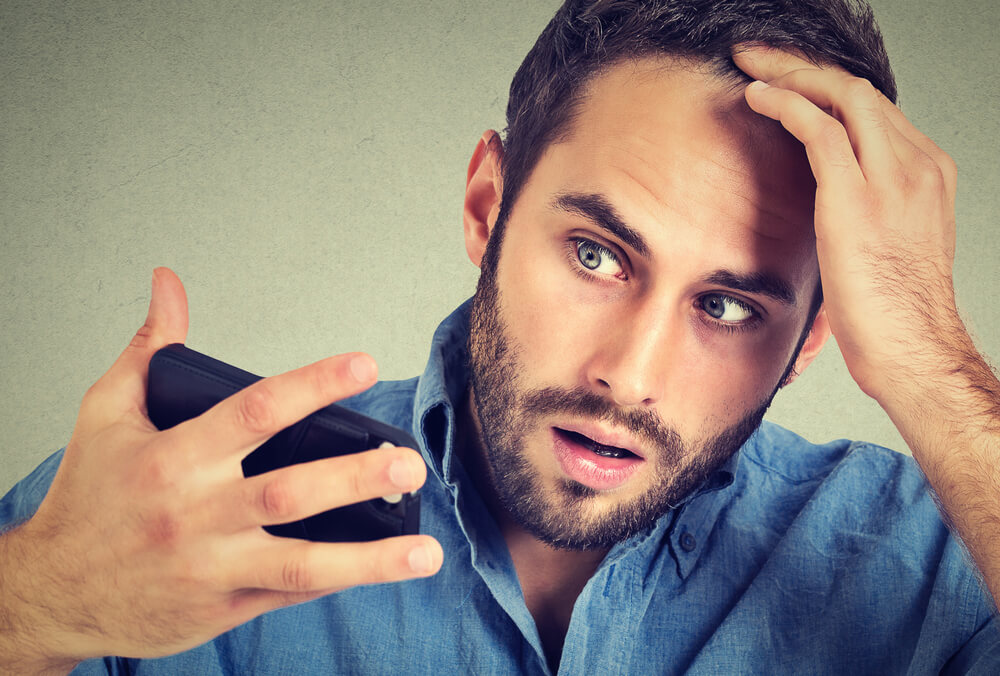How to Treat Hair Loss in Men
Hair loss in men is a common phenomena especially as men approach the age of 40 and older.
Hair loss due to age is caused by too much of a hormone called dihydrotestosterone, which can cause hair loss by shrinking hair follicles (the hair tunnels beneath the skin where hair grows).
Men with balding fathers have a greater chance of losing hair since hair loss is genetic.
To learn more about the reasons for hair loss, click on the article: 4 Surprising Medical Reasons for Hair Loss.
Stress relief is one of the most overlooked non-drug therapies to reduce hair thinning in men, and will be addressed in another post.
In this article, we shall discuss the latest therapies for preventing and treating hair loss in men.
Before you read on, check out this excellent summary of treatment options for hair loss from a Board-Certified Dermatologist:
FIRST-LINE THERAPIES FOR HAIR LOSS IN MEN
Topical Minoxidil and Finasteride tablets are the first-line treatments for male hair loss since there is extensive medical evidence showing they are effective. Unfortunately, once you stop taking these therapies, you will start losing hair again. Let’s discuss each therapy in further detail below.
Minoxidil Topical Solution/Foam: Topical minoxidil comes as a 5% solution or foam and is a first-line treatment for hair loss in men. We recommend the 5% foam over the solution as it is easier to apply and has less skin irritation. Minoxidil most likely stimulates hair growth by activating proteins called hair growth factors on your scalp that increase blood flow to your hair follicles.
Minoxidil foam must be applied twice daily onto the scalp for maximal benefit. You will need to be patient because it usually takes about 4 months to begin to see your hair grow back. You may lose hair in the first 2 months, so do not worry as this is normal. Maximal benefit is seen after about 12-18 months of using minoxidil. If you stop taking minoxidil, however, you will begin losing hair again, so treatment with minoxidil is indefinite. You can even combine topical minoxidil with finasteride tablets.
Finasteride tablet: Finasteride is usually used to shrink an enlarged prostate in men, but studies have found that lower doses help with hair loss as well. Finasteride blocks more than 60% of dihydrotestosterone on your scalp, which is the hormone responsible for hair loss. Hair growth does not happen overnight, however. You will need take finasteride for at least a year to determine if it will help your hair to grow. Many men in clinical trials took finasteride for 4 years to see maximal hair growth effects. Finasteride can help you grow hair in all parts of your scalp, but it is most effective on the the crown, middle, and front parts of your scalp. Finasteride is more effective in men younger than 40, but it is still effective in men over 40. If you stop taking finasteride, however, you will begin losing hair again within 6 to 9 months. You can even combine finasteride tablets with topical minoxidil.
The recommended dose of finasteride is 1mg daily, which is available under the brand name Propecia 1 mg tablet. However, most insurances will not cover Propecia, since male baldness is considered a cosmetic condition. Your doctor may prescribe you the generic finasteride 5mg tablets instead, which are usually covered by most insurances. The doctor will tell you to break the tablets in half because the 5mg dose is too high to treat hair loss.
The main drawback of finasteride is the sexual side effects, including decreased sexual drive and erectile dysfunction. These side effects are usually reversible after you stop taking finasteride. However, a survey of 71 men who took finasteride for about 2 years reported sexual side effects even after stopping finasteride (J Sex Med. 2011). About 14 of these men still had sexual side effects after 6 years of stopping finasteride. The risk of permanent sexual side effects appears to be low but it is important to be aware that they exist, especially for the men who took finasteride for about 2 years on average.
The video below is a good summary of first-line treatments for hair loss in men.
OTHER THERAPIES FOR HAIR LOSS IN MEN
The next list of therapies have some data to show they may be effective for hair loss in men. With the exception of hair transplant surgery, the data for these other therapies are much weaker than for finasteride and topical minoxidil.
Biotin: We are neither for or against using Biotin for male hair loss. There is not much medical evidence that Biotin works for hair loss in men, but it doesn’t hurt to try. You can even combine it with Zinc, which is found in a daily multivitamin. Just do not take more than 2,500 mcg per day. Biotin doses of 5,000 mcg or higher have been known to alter certain lab tests such as thyroid tests. We recommend Nature Made’s Biotin 2500mcg, which you can purchase from Amazon by clicking here.
Essential Oils: We are neither for or against using essential oils for male hair loss. There is not much medical evidence that essential oils work for hair loss, but it doesn’t hurt to try. One small study showed that massaging essential oils (thyme, rosemary, lavender, and cedarwood) in a mixture of carrier oils (jojoba and grapeseed) into your scalp daily can potentially improve hair growth.
Hair Transplant Surgery: A permanent way to resolve hair loss in men is hair transplant surgery. Hair is usually taken from the back of your head and transplanted into the balding areas of your scalp. There are two types of surgeries: follicular unit transplantation and follicular unit extraction.
- Follicular Unit Transplantation: Follicular Unit Transplantation is definitely the more invasive of the two types of surgeries. Your surgeon will use an anesthetic to numb the back of your head and then slice out a small area of hair that can be transplanted onto balding areas of your scalp. Follicular Unit Transplantation will leave a scar line on the back of your head. See the video below for a visual overview of this type of surgery.
- Follicular Unit Extraction: Follicular Unit Extraction is the less invasive option of the two types of hair transplant surgeries. This tedious process will extract each hair unit one by one from the back of your head and transplant them onto the balding areas of your scalp. Although follicular unit extraction is more time-consuming than follicular unit transplantation, it will not leave a scar line on the back of your head. See the video below.
Hair transplant surgery usually takes about 5-8 hours and you will probably be encouraged to continue finasteride and minoxidil after surgery, especially to prevent hair loss in the areas of the scalp that do not have the transplanted hair.
Ketoconazole 2% Shampoo: Ketoconazole 2% shampoo is a prescription shampoo and has been shown to increase hair density in men after 6 months of use. Ketoconazole 2% shampoo should be used two to four times every week. It is definitely worth a shot since it is inexpensive and available at most pharmacies. Ketoconazole 2% shampoo can be combined with other therapies like minoxidil foam and finasteride tablets. There is also a lower strength Ketoconazole 1% shampoo (Nizoral) that is available over-the-counter, but it make not work as well.
Latanoprost: Latanoprost is a prescription eye drop that is used for glaucoma. However, studies have shown that latanoprost may also be helpful for hair loss in men. This comes as no surprise because latanoprost’s cousin, bimatoprost (Latisse), helps with eyelash growth. One small trial showed that latanoprost applied topically to the scalp may help with male hair loss after 6 months of use, but it was a small trial so further studies are needed.
Light Therapy: Light therapy appears to be a promising therapy for hair loss in both men and women. Low level laser light therapy seems to stimulate the stem cells in hair growth follicles to promote hair growth. Two clinical trials that studied about 300 male and female patients showed increase in hair density when low level laser light therapy combs were used three times per week for about 6 months (Am J Clin Dermatol 2014, Clin Drug Investig 2009). Low level laser light therapy is available by many manufacturers as a laser comb, laser band, and laser helmet or cap. Several FDA-cleared products will be discussed below.
The HairMax LaserComb® is one of the laser phototherapy devices that was tested in the previously mentioned clinical trials and is cleared by the FDA as safe for use. Since then, HairMax® has come out with a Laser Cap, Laser Band, and other Laser Combs.
Below is a video of The HairMax Ultima 12 LaserComb:
Below is a video of The HairMax LaserBand 82:
Below is a video of The HairMax Laser 272 PowerFlex Cap:
In this section, we highlighted the company HairMax based on the available medical studies. Other companies that sell similar FDA-cleared light therapy products include Cappilus, LaserCap, and Theradome. They all sell similar products but costs will vary based on the manufacturer. We shall briefly go over some of the features of these companies below.
HairMax was granted the first FDA-cleared laser phototherapy device for home use to treat hair loss. HairMax has a wide variety of laser devices including a Laser Comb, Laser Band, and Laser Cap. The prices of each device varies from as low as $199-$399 for the LaserComb, $549-$799 for the LaserBand, to as high as $1,899 for the Laser Cap. The LaserComb and LaserBand devices have a 6 month money back guarantee, and the Laser Cap device has a 1 year money back guarantee (minus a restocking fee). All laser therapy devices have a 2 year warranty. Make sure to also look for any coupon codes located at the top of the website or any discounts that pop up once you visit their website.
Cappillus also sells laser devices but only in the form of a laser cap, which are priced from $799 to $2,999. These laser caps have a 1 year money back guarantee (minus a restocking fee) and 1 year limited warranty. Make sure to also look for any coupon codes located at the top of the website or a any discounts that pop up once you visit their website.
Theradome sells low level laser light therapy in the form of a laser helmet, which are priced from $595 to $895. These laser helmets have a 6 month money back guarantee (minus a restocking fee) and a 1 year warranty. Make sure to also look for any coupon codes located at the top of the website or a any discounts that pop up once you visit their website.
LaserCap also sells laser devices but only in the form of a laser cap. There are 3 LaserCap choices available but prices are not available on the website without consulting with one of their doctors. These laser caps have a 1 year money back guarantee (minus a restocking fee) and a lifetime warranty.
Platelet-rich plasma (PRP): The results are mixed whether PRP is an effective therapy for male hair loss. One clinical trial showed benefit, whereas another trial did not. More data is needed before we can recommend PRP therapy for hair loss in men. PRP therapy is also very expensive and it is unclear if hair loss will return once you stop receiving treatments.
Saw Palmetto: Saw Palmetto is an herbal supplement that comes from a fruit palm tree. This herbal is usually used to help shrink an enlarged prostate and is thought to work similarly to the prescription drug finasteride, which we discussed earlier. Saw Palmetto is thought to slow hair loss by inhibiting the production of the hormone dihydrotestosterone, which is responsible for shrinking your hair follicles. One small clinical trial showed benefit in 60% of the enrolled patients who used Saw Palmetto 200mg twice daily (J Altern Complement Med. 2002). However, there is simply not enough medical evidence to recommend Saw Palmetto for hair loss. More studies are needed before we can recommend this herbal supplement for hair loss.
Zinc: We are neither for or against using Zinc for male hair loss. There is not much medical evidence that Zinc works for hair loss in men, but it doesn’t hurt to try. You can even combine it with Biotin. For adult men, we recommend an adequate daily intake of 11 mg, which you can get from a daily multivitamin.



